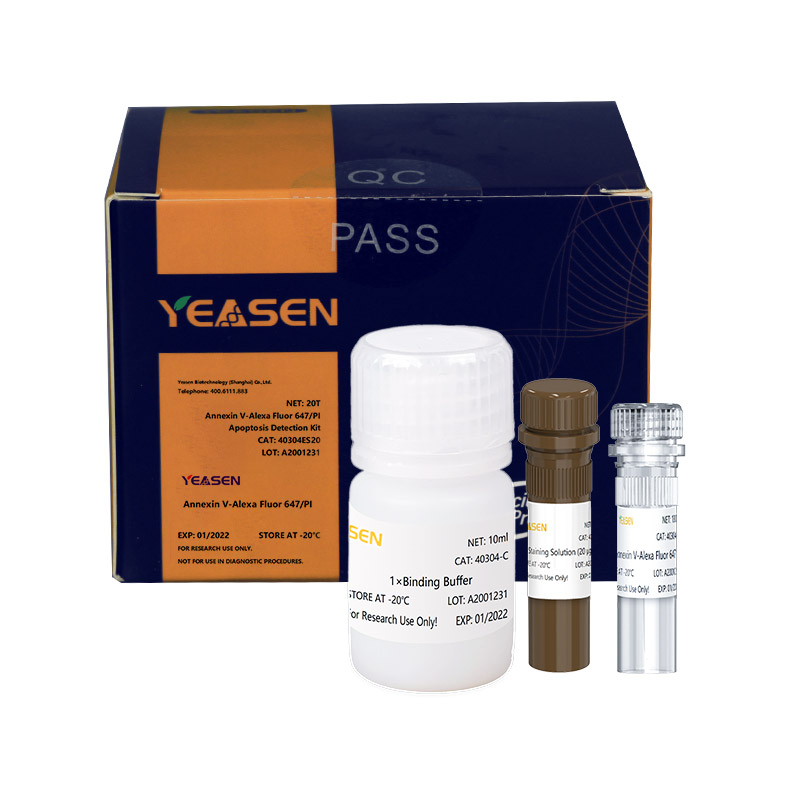Annexin V-YSFluorTM 647/PI Apoptosis Detection Kit
Product Information
|
Product name |
Cat# |
Specification |
|
Annexin V-YSFluorTM 647/PI Apoptosis Detection Kit |
40304ES20 |
20 T |
|
|
40304ES50 |
50 T |
|
|
40304ES60 |
100 T |
Product Description
Annexin V-YSFluorTM 647/PI Apoptosis Detection Kit is an Annexin Fluor 647 labeled with Annexin V as a probe to detect the occurrence of early apoptosis, which can be detected by flow cytometry or other fluorescence detection equipment.
The detection principle is that in normal living cells, phosphotidylserine (PS) is located on the inner side of the cell membrane, but in early apoptotic cells, PS reverses from the inner side to the surface of the cell membrane and is exposed to the extracellular environment. Annexin V is a Ca2+ -dependent phospholipid binding protein with a molecular weight of 35-36 kD that binds PS with high affinity. Phosphatidylserine can bind to the membrane of early-apoptotic cells by exposing it laterally.
In addition, Propidium Iodide (PI) is provided in this kit to distinguish between surviving early cells and necrotic or late apoptotic cells. PI is a kind of nucleic acid dye, which can not penetrate the intact cell membrane of normal cells or early apoptotic cells, but can penetrate the cell membrane of late apoptotic and necrotic cells and make the cell nucleus red. Therefore, when Annexin V was used in combination with PI, PI was excluded from living cells (Annexin V-/PI-) and early apoptotic cells (Annexin V+/PI-). The apoptotic and necrotic cells were double positive by YSFluorTM 647 and PI binding staining (Annexin V+/PI+).This kit requires flow cytometry.
Components
|
Component |
|
40304ES20(20T) |
40304ES50(50T) |
40304ES60(100T) |
|
40304-A |
Annexin V-YSFluorTM 647 |
100 μL |
250 μL |
500 μL |
|
40304-B |
PI Staining Solution (20 μg/mL) |
200 μL |
500 μL |
1.0 mL |
|
40304-C |
1×Binding Buffer |
10 mL |
25 mL |
50 mL |
Shipping and Storage
The components are shipped with ice pack and can be stored at -20°C for 1 year.
Cautions
- As cell apoptosis is a rapid process, it is recommended that samples be analyzed within 1 hour after staining.
- Digestion is a critical step for adherent cells. When adherent cells induce cell apoptosis, if there are floating cells, floating cells and adherent cells should be collected and combined with staining. When handling adherent cells, be careful to avoid artificial damage to cells.
- If the sample comes from blood, be sure to remove platelets from the blood. Because platelets contain PS, Annexin V binds and interferes with the results.
- Please centrifuge the reagent briefly before opening the cover, and throw the liquid on the inner wall of the cover to the bottom of the tube to avoid liquid spilling when opening the cover.
- Annexin V-YSFluorTM 647 and PI are photosensitive substances, please avoid light when operating.
- For your safety and health, please wear lab coat and disposable gloves for operation.
- For research use only!
Instructions
1. Sample dyeing
1.1 suspension cells: 300 g, centrifuged at 4℃ for 5 mins to collect cells.
Adherent cells: After digestion with trypsin without EDTA, cells were collected by centrifugation at 300 g at 4℃ for 5 mins. Trypsin digestion time should not be too long to prevent false positive.
1.2. Cells were washed twice with pre-cooled PBS, 300 g each time, centrifuged at 4℃ for 5 mins.
1.3. Discard PBS and add 100 μL 1×Binding Buffer to resuscitate cells.
1.4. Add 5 μL Annexin V-YSFluorTM 647 and 10 μL PI, mix gently.
1.5. The reaction was conducted at room temperature for 15 mins, away from light.
1.6. 400 μL 1×Binding Buffer was added, and the samples were mixed and placed on ice. The samples were detected by flow cytometry or fluorescence microscope within 1 hour.
【Notes】: In order to avoid the loss of cells when washing cells, a small tip can be used to suck liquid.
2. Flow cytometry analysis
YSFluorTM 647 has a maximum excitation wavelength of 651 nm and a maximum emission wavelength of 667 nm; The maximum excitation wavelength of pi-DNA complex is 535 nm, and the maximum emission wavelength is 615 nm. Analysis was performed using CellQuest and other software to plot two-color dot plots with YSFluorTM647 as abscissa and PI as ordinates. 10,000 events were collected for each sample.
[1] Qu S, Jiao Z, Lu G, et al. PD-L1 lncRNA splice isoform promotes lung adenocarcinoma progression via enhancing c-Myc activity. Genome Biol. 2021;22(1):104. Published 2021 Apr 13. doi:10.1186/s13059-021-02331-0(IF:13.583)
[2] Wang J, Du X, Wang X, et al. Tumor-derived miR-378a-3p-containing extracellular vesicles promote osteolysis by activating the Dyrk1a/Nfatc1/Angptl2 axis for bone metastasis. Cancer Lett. 2022;526:76-90. doi:10.1016/j.canlet.2021.11.017(IF:8.679)
[3] Xie J, Xu W, Wu Y, Niu B, Zhang X. Macroporous organosilicon nanocomposites co-deliver Bcl2-converting peptide and chemotherapeutic agent for synergistic treatment against multidrug resistant cancer. Cancer Lett. 2020;469:340-354. doi:10.1016/j.canlet.2019.10.018(IF:6.508)
[4] Li S, Li X, Chen F, et al. Nobiletin mitigates hepatocytes death, liver inflammation, and fibrosis in a murine model of NASH through modulating hepatic oxidative stress and mitochondrial dysfunction. J Nutr Biochem. 2022;100:108888. doi:10.1016/j.jnutbio.2021.108888(IF:6.048)
[5] Han L, Wu Y, Liu F, Zhang H. eIF4A1 Inhibitor Suppresses Hyperactive mTOR-Associated Tumors by Inducing Necroptosis and G2/M Arrest. Int J Mol Sci. 2022;23(13):6932. Published 2022 Jun 22. doi:10.3390/ijms23136932(IF:5.924)
[6] Gao F, Wang Q, Zhang C, et al. RNA methyltransferase METTL3 induces intrinsic resistance to gefitinib by combining with MET to regulate PI3K/AKT pathway in lung adenocarcinoma. J Cell Mol Med. 2021;25(5):2418-2425. doi:10.1111/jcmm.16114(IF:5.310)
[7] Ren L, Hu L, Zhang Y, et al. Cataract-Causing S93R Mutant Destabilized Structural Conformation of βB1 Crystallin Linking With Aggregates Formation and Cellular Viability. Front Mol Biosci. 2022;9:844719. Published 2022 Mar 14. doi:10.3389/fmolb.2022.844719(IF:5.246)
[8] Ding M, Weng C, Fan S, Cao Q, Lu Z. Purkinje Cell Degeneration and Motor Coordination Deficits in a New Mouse Model of Autosomal Recessive Spastic Ataxia of Charlevoix-Saguenay. Front Mol Neurosci. 2017;10:121. Published 2017 May 1. doi:10.3389/fnmol.2017.00121(IF:5.076)
[9] Cai C, Dang W, Liu S, et al. Anthrax toxin receptor 1/tumor endothelial marker 8 promotes gastric cancer progression through activation of the PI3K/AKT/mTOR signaling pathway. Cancer Sci. 2020;111(4):1132-1145. doi:10.1111/cas.14326(IF:4.966)
[10] Li X, Yao Q, Huang J, et al. Morin Hydrate Inhibits TREM-1/TLR4-Mediated Inflammatory Response in Macrophages and Protects Against Carbon Tetrachloride-Induced Acute Liver Injury in Mice. Front Pharmacol. 2019;10:1089. Published 2019 Sep 20. doi:10.3389/fphar.2019.01089(IF:3.845)
[11] Jiang Y, Du M, Wu M, et al. Phosphatidic Acid Improves Reprogramming to Pluripotency by Reducing Apoptosis. Stem Cells Dev. 2016;25(1):43-54. doi:10.1089/scd.2015.0159(IF:3.727)
[12] Zhang Q, Wu C, Fan Y, et al. Nucleic acid-targeted pathogen reduction technique in red blood cells by UV-generated oxygen radicals for optimising recipient safety. Transfus Med. 2020;30(1):51-60. doi:10.1111/tme.12654(IF:1.900)
Catalog No.:*
Name*
phone Number:*
Lot:*
Email*
Country:*
Company/Institute:*
Related articles

